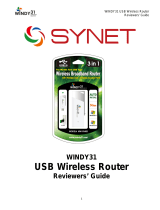
© Copyright 2012 TRENDnet. All Rights Reserved.
TRENDnet User’s Guide
TEW-716BRG
14
Steps to improve wireless connectivity
There are a number of factors that can impact the range of wireless devices. Follow
these tips to help improve your wireless connectivity:
1. Keep the number of obstructions to a minimum. Each obstruction can reduce the
range of a wireless device. Position the wireless devices in a manner that will
minimize the amount of obstructions between them.
a. For the widest coverage area, install your router near the center of your home,
and near the ceiling, if possible.
b. Avoid placing the router on or near metal objects (such as file cabinets and metal
furniture), reflective surfaces (such as glass or mirrors), and masonry walls.
c. Any obstruction can weaken the wireless signal (even non-metallic objects), so
the fewer obstructions between the router and the wireless device, the better.
d. Place the router in a location away from other electronics, motors, and
fluorescent lighting.
e. Many environmental variables can affect the router’s performance, so if your
wireless signal is weak, place the router in several locations and test the signal
strength to determine the ideal position.
2. Building materials can have a large impact on your wireless signal. In an indoor
environment, try to position the wireless devices so that the signal passes through
less dense material such as dry wall. Dense materials like metal, solid wood, glass or
even furniture may block or degrade the signal.
3. Antenna orientation can also have a large impact on your wireless signal. Use the
wireless adapter’s site survey tool to determine the best antenna orientation for your
wireless devices.
4. Interference from devices that produce RF (radio frequency) noise can also impact
your signal. Position your wireless devices away from anything that generates RF
noise, such as microwaves, radios and baby monitors.
If possible, upgrade wireless network interfaces (such as wireless cards in computers)
from older wireless standards to 802.11n. If a wirelessly networked device uses an older
standard, the performance of the entire wireless network may be slower. If you are still
experiencing low or no signal consider repositioning the wireless devices or installing
additional access points.
Access Control Filters
Access control basics
MAC address filters
Security Setting > MAC Control
Every network device has a unique, 12-digit MAC (Media Access Control) address. Using
MAC filters, you can allow or deny specific computers and other devices from using this
router’s wired or wireless network.
1. Log into your router management page (see “
Access your router management page”
on page 18).
2. Click on Access, click on Filter, and click on MAC Filters.
3. Click Enable to enable MAC Address Control rule.
4. Select the type of restrictions you would like to apply to the MAC control rule.
• Connection control: Check "Connection control" to enable the controlling of which
wired and wireless clients can connect with this device. If a client is denied to
connect with this device, it means the client can't access to the Internet either.
Choose "allow" or "deny" to allow or deny the clients, whose MAC addresses are
not in the "Control table" (please see below), to connect with this device.
• Association control: Check "Association control" to enable the controlling of which
wireless client can associate to the wireless LAN. If a client is denied to associate to
the wireless LAN, it means the client can't send or receive any data via this device.
Choose "allow" or "deny" to allow or deny the clients, whose MAC addresses are
not in the "Control table", to associate to the wireless LAN.
4. Review the MAC Filter options and click Save to apply settings.
• MAC Address – Enter the 12-digit MAC address.(e.g. 00-11-22-AA-BB-CC)
• C or A: Select which rule you would like to apply on the applied MAC address.





















